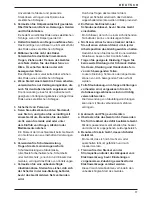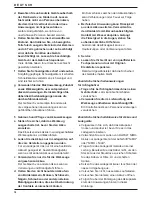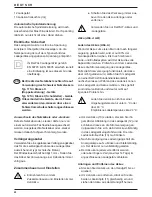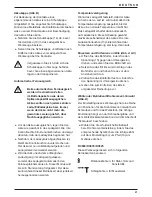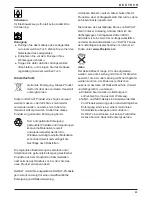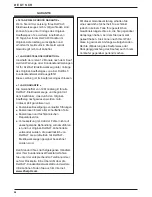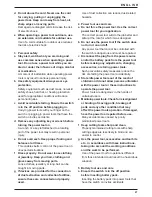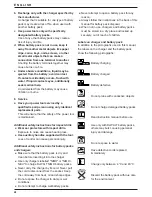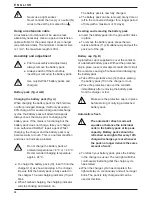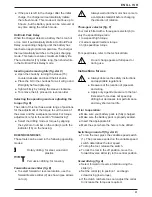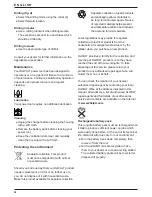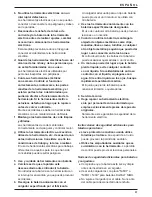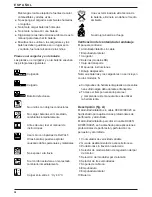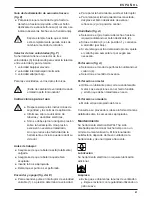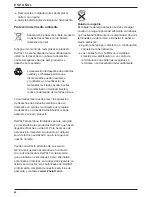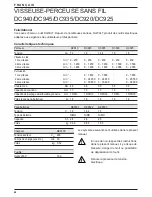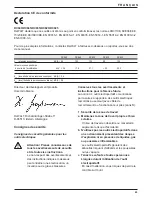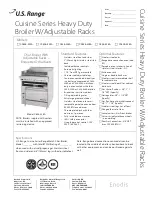
30
E N G L I S H
Never use a light socket.
Never connect the live (L) or neutral (N)
wires to the earth pin marked E or .
Using an extension cable
An extension cord should not be used unless
absolutely necessary. Use an approved extension
cable suitable for the power input of your charger
(see technical data). The minimum conductor size
is 1 mm
2
; the maximum length is 30 m.
Assembly and adjustment
● Prior to assembly and adjustment,
always remove the battery pack.
● Always switch off the tool before
inserting or removing the battery pack.
Use only D
E
WALT battery packs and
chargers.
Battery pack (fi g. A & B)
Charging the battery pack (fi g. A)
When charging the battery pack for the fi rst time,
or after prolonged storage, it will only accept an
80% charge. After several charge and discharge
cycles, the battery pack will attain full capacity.
Always check the mains prior to charging the
battery pack. If the mains is functioning but the
battery pack does not charge, take your charger
to an authorised D
E
WALT repair agent. Whilst
charging, the charger and the battery pack may
become warm to touch. This is a normal condition
and does not indicate a problem.
Do not charge the battery pack at
ambient temperatures < 4 °C or > 40 °C.
Recommended charging temperature:
approx. 24 °C.
● To charge the battery pack (10), insert it into the
charger (12) as shown and plug in the charger.
Be sure that the battery pack is fully seated in
the charger. The red charging indicator (13) will
blink.
● When fi nished charging, the charging indicator
will stop blinking and remain on.
The battery pack is now fully charged.
● The battery pack can be removed at any time or
left in the connected charger for a longer period
of time (with a maximum of 14 days).
Inserting and removing the battery pack
● Insert the battery pack into the grip until it clicks
in place.
● To remove the battery pack, press the two
release buttons (11) simultaneously and pull the
pack out of the grip.
Battery cap (fi g. B)
A protective cap is supplied to cover the contacts
of a detached battery pack. Without the protective
cap in place, loose metal objects could short circuit
the contacts, causing a fi re hazard and damaging
the battery pack.
● Take off the protective cap (14) before placing
the battery pack (10) in the charger or tool.
● Place the protective cap over the contacts
immediately after removing the battery pack
from the charger or tool.
Make sure the protective cap is in place
before storing or carrying a detached
battery pack.
Automatic refresh
The automatic refresh mode will
equalize or balance the individual
cells in the battery pack at its peak
capacity. Battery packs should be
refreshed overnight after every 10th
charge/discharge cycle or whenever
the pack no longer delivers the same
amount of work.
● To refresh your battery pack, place the battery
in the charger as usual. The red light will blink
continuously indicating that the charge cycle
has started.
● When the charge cycle has completed, the
light will stay on continuously and will no longer
blink. The pack is fully charged and can be
used at this time.
Summary of Contents for DC920
Page 1: ...DC940 DC945 DC935 DC920 DC925 ...
Page 3: ...3 A 3 2 1 11 10 13 12 9 8 10 7 4 5 6 3 2 1 9 8 10 7 4 5 6 ...
Page 4: ...4 B C 14 10 14 10 15 15 4 16 D ...
Page 5: ...5 E F 2 6 ...
Page 129: ...129 ...
Page 130: ...130 ...
Page 131: ...131 ...


